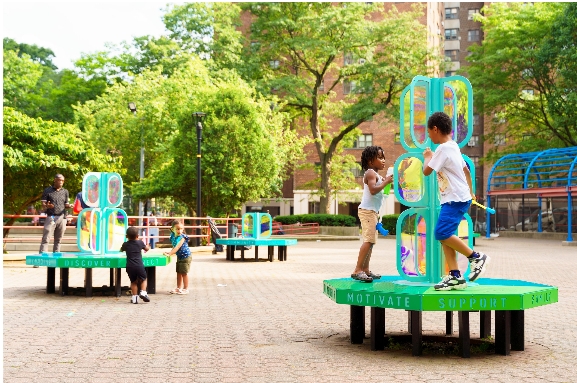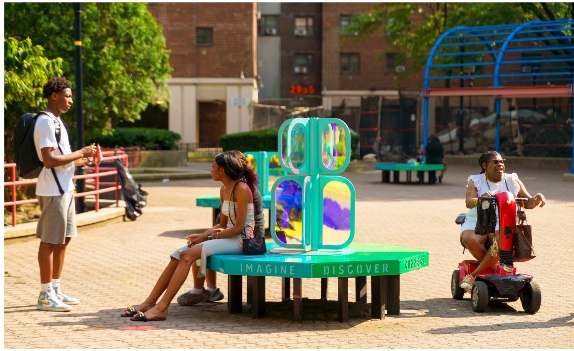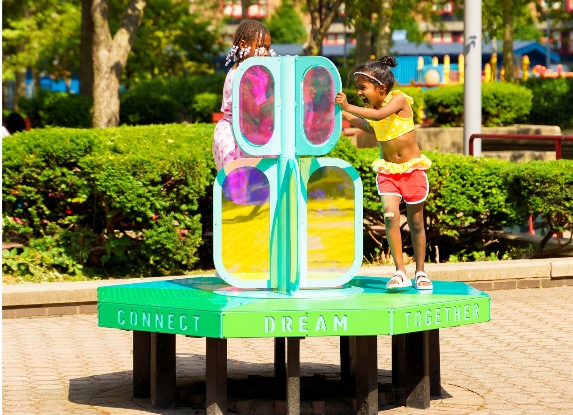“Sprout”: A Neurodiverse Playscape in the Heart of Harlem
At Polo Grounds Towers in Upper Manhattan, an innovative project called Sprout has transformed what had been an aging outdoor space into a vibrant, inclusive “playscape” designed to bring the community together. This multisensory playscape, created through a thoughtful and intentional collaboration with the Polo Grounds community, represents an important new approach to public space design. It not only provides a space for play but also fosters connection, inspiration, and dialogue among residents of all ages and abilities.
This month, Sprout was named an “Honoree” in the Social Impact project category for Interior Design magazine’s prestigious “Best of the Year” awards. This recognition celebrates both Sprout’s transformative impact on the Polo Grounds community and its creators’ innovative approach to public space design.



Sprout is part of the Mayor’s Action Plan for Neighborhood Safety, an initiative aimed at enhancing community well-being in NYCHA developments since 2018. The Polo Grounds stakeholder team (NSTAT), in partnership with the Center for Court Innovation, worked with the Urban Conga design group to create a public space that prioritizes neurodiversity and equitable access. The effort redefines what safety, mental health and well-being can look like in urban settings, emphasizing the power of communal engagement and thoughtful design.
“Sprout highlights the importance of neurodiversity and equitable play spaces in urban planning, putting the community at the forefront of design,” said Jose Torres of the Center for Court Innovation.
“Vibrant, inclusive public spaces make communities safer,” said Naudia Williams of the Mayor’s Action Plan for Neighborhood Safety. “This playscape is the product of the City government investing in the expertise of residents who know what they need to thrive.”
The design process for Sprout was deeply rooted in community participation. Through workshops and discussions, residents shared their stories, experiences, and visions to help create a space that reflects their unique needs. Their insights shaped the final design, ensuring the playscape genuinely represents the community’s creativity and its collective voice.

“It’s inspiring to see how engaged residents were throughout the design process,” said Joanne Wu, a Community Design Associate at NYCHA who previously worked as a consultant at the Urban Conga and who participated directly in the engagement and design behind the project. “The collaborative approach allowed them to truly feel a sense of ownership over the space.”
“This partnership project exemplifies the strength of collaboration between City agencies and NYCHA’s valued community organization partners,” said Vaidehi Mody, Senior Planning Consultant for Architecture and Engineering Services in NYCHA’s Asset and Capital Management Department. “Together, we’re breaking new ground with NYCHA’s first-ever neurodiverse-focused intervention, demonstrating how thoughtful design can preserve existing elements while creating inclusive, innovative spaces for our residents.”
Collaboration with the Mayor’s Action Plan initiative is a part of NYCHA’s Connected Communities program, which is focused on transforming and modernizing open spaces by implementing partnerships with community organization partners and City agencies. The program’s efforts are based on participatory planning and design, and they aim to enhance vibrant, safer, and more resilient open spaces in NYCHA communities.

said Jose Torres of the Center for Court Innovation.
The Sprout playscape repurposed four existing benches into an interactive, multisensory experience. Designed to accommodate neurodiverse users, the space incorporates varying textures, colors, reflections, movements, and sounds. These elements offer users the freedom to engage with the playscape in ways that align with their preferred ways to play, intentionally fostering inclusivity and creativity for everyone.
The design features four distinct pieces, each resembling sprouts emerging from the ground, suggesting growth and new beginnings. The structures vary in height and functionality, encouraging both individual and collaborative varieties of play. The first piece offers a serene, quiet space; the others incorporate kinetic elements like reflective, color-changing leaves that can be spun.
Words of affirmation chosen by the community — for example “discover,” “support,” and “connect” — wrap visibly around the bases of the structures. The words and phrases are meant to spark introspection and conversation, thus making the playscape more than just a purely physical opportunity. The pastel color palette and the tactile surfaces of the pieces further enhance what is both a calming yet stimulating environment, making it a welcoming retreat for Polo Grounds residents and their guests.

The Urban Conga, a Brooklyn-based design studio, played an indispensable role in bringing Sprout to life. Led by Ryan Swanson and Maeghann Coleman, Urban Conga specializes in creating open-ended play opportunities that foster social interaction and creativity. Their participatory design approach ensures that the communities they work with are integral to the creative process, resulting in spaces that resonate deeply with their users, who are genuinely also their co-creators.
To watch a brief video about the Urban Conga playspace at Polo Grounds Towers, click here.

